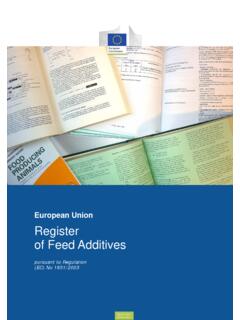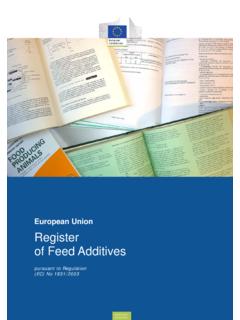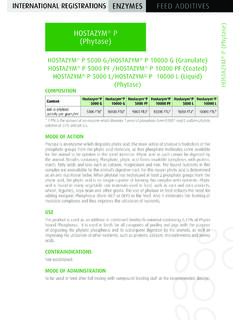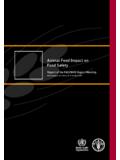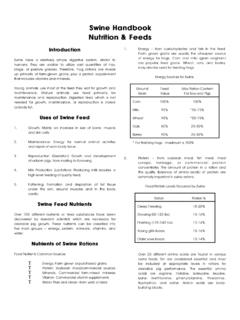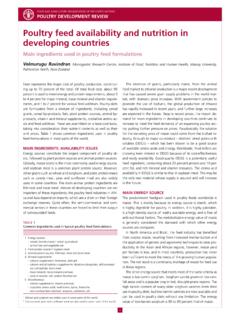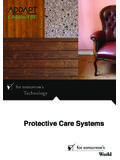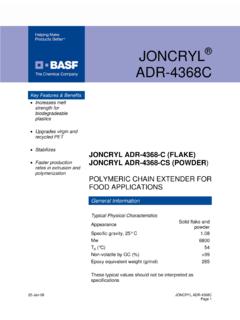Transcription of FOR FEED ADDITIVES AND - FAMI-QS Certification …
1 Version 2014-02-14 EUROPEAN CODE OF GOOD PRACTICE FOR feed ADDITIVES AND PREMIXTURES OPERATORS FAMI-QS Code of Practice Version , 2014-02-14 Page 2/43 EUROPEAN CODE OF PRACTICE FOR feed ADDITIVES AND PREMIXTURES OPERATORS TABLE OF CONTENTS 1 INTRODUCTION .. 4 2 SCOPE .. 6 3 TERMS AND DEFINITIONS .. 7 4 MANAGEMENT SYSTEM (MS) .. 12 General requirements .. 12 Management Principles .. 12 General documentation requirements .. 13 5 MANAGEMENT RESPONSIBILITY .. 15 Management commitment .. 15 Quality and safety policy .. 15 Responsibility, authority and communication .. 15 Management representative .. 16 Management review .. 16 6 RESOURCE MANAGEMENT .. 18 Provision of resources .. 18 Human resources .. 18 Competence, awareness and training .. 18 Personal Hygiene .. 18 Infrastructure .. 19 Basic requirements.
2 19 Requirements for facilities, production areas and equipment .. 19 Facilities & production Areas .. 19 Equipment .. 20 Maintenance and control of monitoring and measuring devices .. 20 Cleaning .. 21 Pest control .. 22 Waste control .. 23 7 PRODUCT 24 Product requirements .. 24 FAMI-QS Code of Practice Version , 2014-02-14 Page 3/43 Determination of requirements related to the product .. 24 Compliance of the product to the requirements .. 24 Customer communication .. 24 HACCP Programme .. 25 Design and development .. 26 Development of new products and processes .. 26 Change control .. 26 Handling of incoming materials .. 27 Sourcing of incoming materials .. 27 Verification of incoming materials .. 28 Production of finished goods .. 29 Quality Control and Production .. 29 Verification of processes for production .. 31 Identification and traceability.
3 32 Preservation of product .. 32 Transport .. 33 General requirements .. 33 Transport of packaged goods .. 33 Transport of bulk products .. 34 8 SYSTEM REVIEW .. 35 General requirements .. 35 Internal audits .. 35 9 CONTROL OF NON-CONFORMING PRODUCTS .. 37 General requirements .. 37 Complaint handling system .. 38 Recall .. 38 Crisis Management .. 39 10 STATISTICAL TECHNIQUES .. 41 11 BIBLIOGRAPHY .. 41 FAMI-QS Code of Practice Version , 2014-02-14 Page 4/43 1 INTRODUCTION This European Code of Practice for Animal feed Ingredients Operators ( Code ) is in line with the Regulation of the European Parliament and the Council laying down requirements for feed hygiene, (Regulation 183/2005/EC), in particular articles 20 to 22 which encourage the development of guides to good practice on hygiene and the application of HACCP principles. Implementation of the Code aims to encourage measures to be put in place to ensure the safety and quality of products covered by FAMI-QS scope; the operation of businesses in accordance with European feed hygiene requirements, and improved traceability.
4 The Code applies equally to import from third countries of these products. The combination of the above principles provides guidance for feed business Operators in implementing the measures necessary to ensure feed safety in European and International manufacturing and trade. In the exceptional case, where a direct or indirect risk to human or animal health is related to a product manufactured and marketed under the Code, the information and recall procedures (including the rapid alert system) defined in Regulation (EC) 178/2002 shall apply. The text of the Code is designed to set out general requirements and to be used by Operators as a tool to develop their own procedures. A compilation of Guidance is provided as annex to the Code. This covers topics of special importance. While the requirements of the Code are mandatory for every Operator, the Guidance provides information on how to deal with specific issues in a more detailed and practical way and may serve as further supporting information to the Code.
5 If the Operator decides to follow the procedures described in the Guidance, this will become a part of its feed Safety Management System. In case that, for good reasons, different procedures are used, the Operator must be able to provide evidence upon request that they comply with the requirements of the Code as well. Both the Code and Guidance will be submitted to periodical review in line with emerging/new relevant technological, scientific and legislative developments or statutory modification in the sector. The aim of this European Code of Practice is to ensure feed safety by: minimizing the risk that unsafe ingredient(s) enter the feed /food chain; enabling an Operator to implement the objectives of the feed Hygiene Regulation (Regulation (EC) 183/2005); and providing measures to ensure that other feed safety regulatory requirements are met.
6 feed is considered unsafe for its intended use if it is likely to pose a risk to (has adverse effect on) human or animal health, or if the food derived from food-producing animals is unsafe for human consumption. This Code shall apply to Operators at all stages of feed production from the first placing on the market based on current EU legislation. Therefore it also applies to the placing on the market after import from third countries. Compliance with FAMI-QS does not exonerate the Operator from meeting the statutory or regulatory requirements in each country in which the Operator is active. The regulatory status of feed ADDITIVES can be checked on the Register of feed ADDITIVES published and frequently updated by the European Commission: FAMI-QS Code of Practice Version , 2014-02-14 Page 5/43 Note: FAMI-QS Code of Practice is a public document and its contents can be freely followed by any feed Business Operator.
7 Running side by side with the Code, FAMI-QS Asbl has developed a parallel and independent Certification system that is described in the Rules for Certification documents (Rules for Certification Bodies Rules for Operators). Participation in the FAMI-QS auditable system is based on voluntary commitment. Please, consult the FAMI-QS web-page to have access to these documents and learn more about how to ensure compliance with this Code of Practice. FAMI-QS Code of Practice Version , 2014-02-14 Page 6/43 2 SCOPE The FAMI-QS scope is described in the last version of the Scope Description Document P-SCD-01. FAMI-QS Code of Practice Version , 2014-02-14 Page 7/43 3 TERMS AND DEFINITIONS The following terms and definitions are used in this Code and associated documents: Adequate: The terminologies adequate , where appropriate , where necessary , or sufficient mean that it is up to the business Operator in first instance to decide whether a requirement is necessary, appropriate, adequate or sufficient to achieve the objectives of the Code.
8 In determining whether a requirement is adequate, appropriate, necessary, or sufficient, account should be taken to the nature of the feed and of its intended use (adopted from EC Guidance Document 2005 on Regulation 852/2004/EC and modified). Agent: An individual or firm authorised to act on behalf of an Operator such as by executing commercial transactions without ever taking legal responsibility of the product and the way it is supplied and provided into the feed chain. Authorised personnel: Persons who have skills, permission and purpose as specified by job descriptions, process descriptions or management. Batch: unit of production from a single plant using uniform production parameters or a number of such units, when produced in continuous order and stored together. It consists of an identifiable quantity of feed which is determined to have common characteristics, such as origin, variety, type of packing, packer, consignor or labelling.
9 (COM(2008)124 final and Regulation 767/2009/EC) Calibration: The demonstration that a particular instrument or device produces results within specified limits by comparison with those produced by a reference or traceable standard over an appropriate range of measurements. Carrier: Substance used to dissolve, dilute, disperse or otherwise physically modify a feed additive in order to facilitate its handling, application or use without altering its technological function and without exerting any technological effect themselves. (COM(2008)124 final & Regulation (EC) 767/2009) Carry-over: Contamination of a material or product with another material or product that originates from previous use of equipment and would alter the quality and safety beyond the established specifications. Check/control: Monitor and measure processes against policies, objectives and requirements for the product and report results.
10 The state wherein correct procedures are being followed and criteria are being met. (Codex Alimentarius) CIP: Cleaning-in-place. Code of Practice: Document identifying the principles of feed hygiene essential to ensure the safety of feed for animals and in turn the safety of animal products intended for human consumption. Compound feed : Mixture of feed materials, whether or not containing feed ADDITIVES , for oral animal feeding in the form of complete or complementary feed . (COM(2008)124 final & Regulation (EC) 767/2009) Contaminant: any biological or chemical agent, foreign matter, or other substances not intentionally added to food or feed which may compromise food and/or feed safety or suitability. (Codex Alimentarius and adapted) Contamination: The undesired introduction of impurities/contaminant (chemical or microbiological nature or of foreign matter), into or onto a raw material, intermediate, and products covered by FAMI-QS scope during production, sampling, packaging or repackaging, storage or transport.








